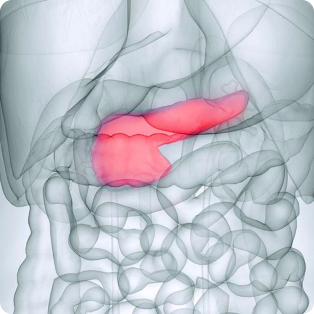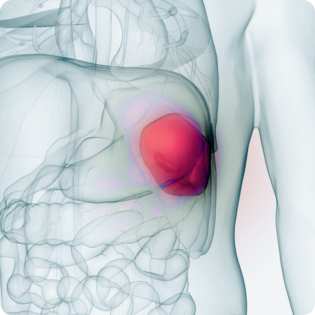The clinical features of familial chylomicronemia syndrome (FCS) may go unrecognized
Many patients experience long delays before receiving a diagnosis, and they suffer heavy burdens as a result12,14
Since FCS is a rare disease, some healthcare professionals may find its clinical features difficult to recognize and diagnose.12,14 A delayed diagnosis may lead to additional risks for those with the condition, including12,21,22,25:
- Recurrent episodes of acute pancreatitis
- Hospitalization including ICU stays
- Increased risk of mortality (5-8% in uncomplicated acute pancreatitis)
- Persistent organ failure
- Significant interference with patients’ lives, social relationships, and activities
Common physical features and complications of FCS

Acute pancreatitis
People with FCS have a 360-fold higher risk of acute pancreatitis than the general population.14 Acute pancreatitis is fatal in 5-8% of uncomplicated cases and as many as 30% of complicated cases. It is also associated with an increased risk of persistent organ failure, endocrine and exocrine pancreatic insufficiency, and type 3C diabetes mellitus.12,21,25, 49

Recurrent abdominal pain
People with FCS may experience single or recurrent episodes of generalized abdominal pain, which can be incapacitating.14

Eruptive xanthoma
Transient eruptive cutaneous xanthomas affect some individuals with FCS and typically affect the trunk and extremities. Xanthomas are often not recognized or mistaken for other skin conditions.12

Hepatosplenomegaly
Hepatomegaly, splenomegaly, or both occur in some people with FCS.12
Other symptoms reported by patients living with FCS12,22
| physical symptoms | Cognitive symptoms |
|---|---|
| Generalized abdominal pain | Difficulty concentrating |
| Bloating | Impaired judgment |
| Asthenia | Brain fog |
| Indigestion | Dementia |
| Fatigue | Memory impairment |
| Dyspnea | |
| Failure to thrive | |
| Lipemia retinalis | |
| Nausea and vomiting |


